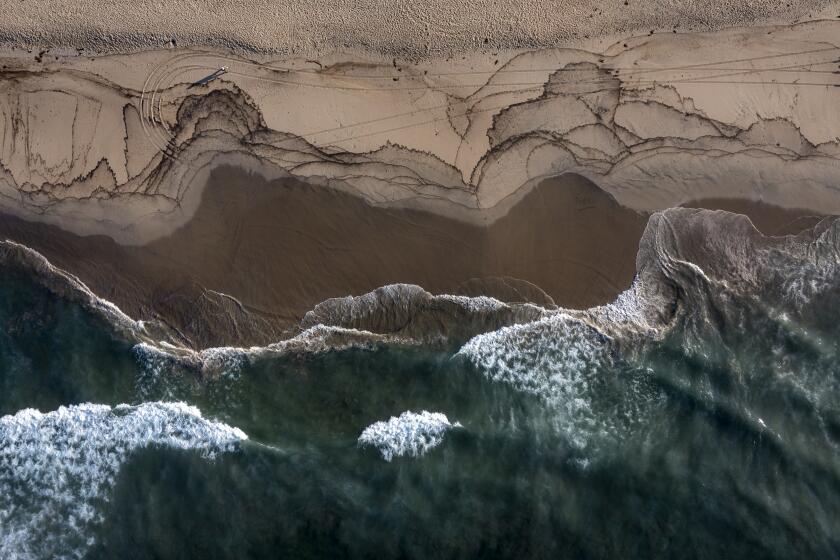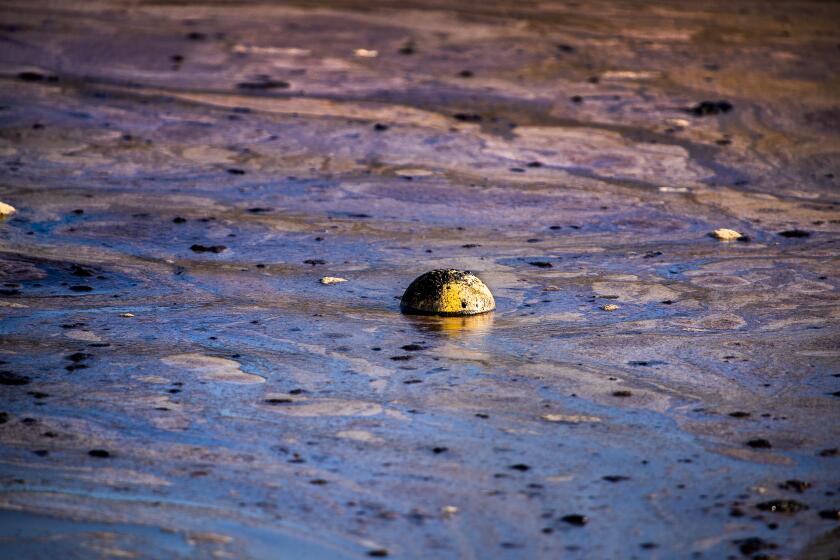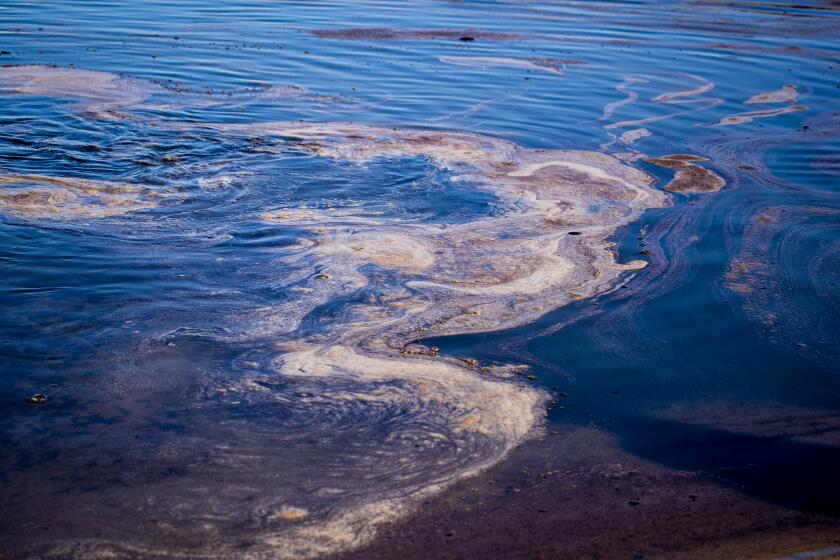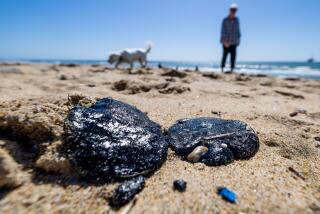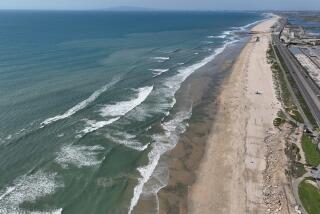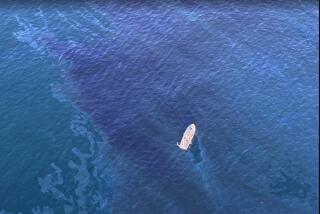Oil spill seeps into O.C.’s coastal wetlands, a critical link along migratory bird route
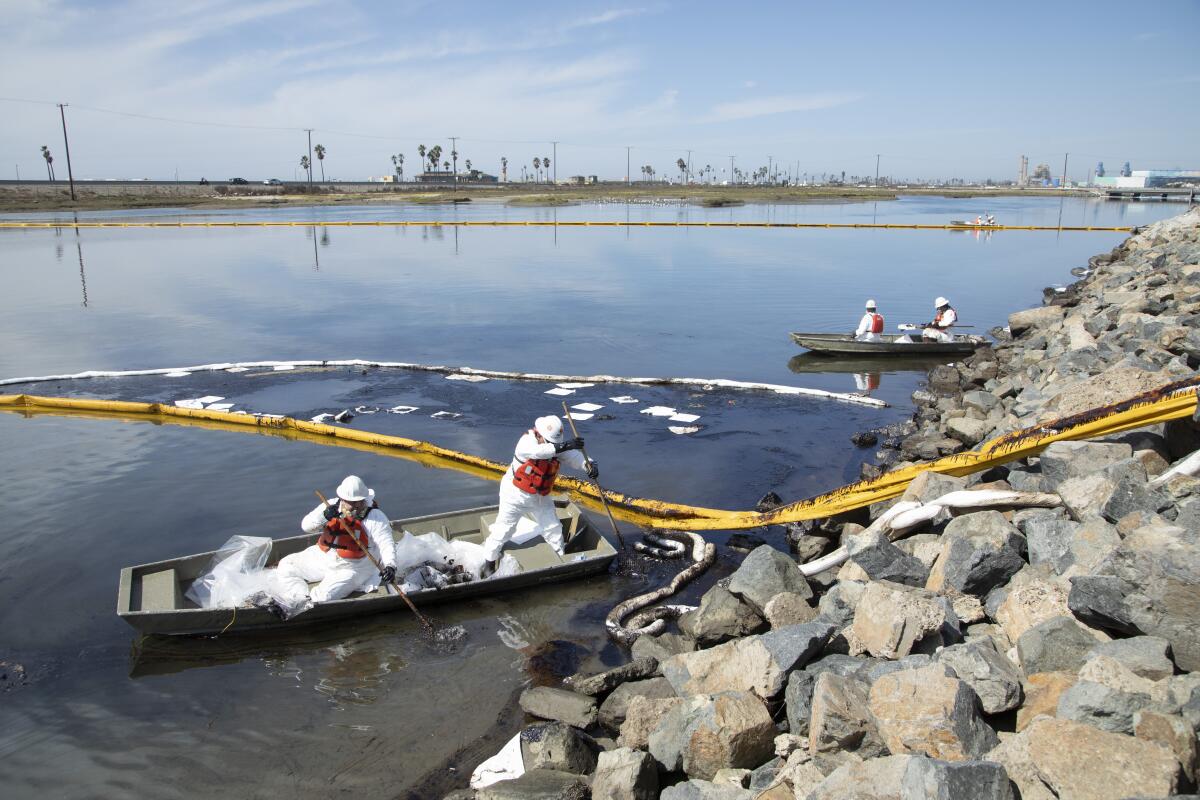
The stench of petroleum permeated the air of Huntington Beach’s Talbert Marsh on Sunday as crews in small boats and sealed inside protective uniforms heaved absorbent pads laden with oil as thick as brownie mix into plastic bags.
A day after a broken pipeline spewed roughly 130,000 gallons of post-productive crude off the Orange County coast, they were part of an effort to clean up oil that had gushed into a two-mile necklace of delicate coastal marshlands — Talbert, Brookhurst, Newland and Magnolia — at high tide early Sunday morning.
By 10 a.m., a rainbow sheen of oil and gooey patches 6 feet across were backing up against yellow floating barriers known as booms installed to facilitate cleanup and preserve the wetlands that remain a critical link along the migratory bird route called the Pacific Flyway, which birds travel from North America to South America.
Workers and city lifeguards also prepared the public beaches for the possible arrival of more oil, raking up kelp and other material that could get in the way of the cleanup.
The scale of the event was a distressing sight for beachgoers such as Bill Grimes, 63, who kept his eyes peeled for dead birds and fish washing up as he waved a metal detector over the sand.
“When are people going to wake up and realize that drilling offshore of Southern California is crazy?” he grumbled.
An oil slick believed to have originated from a pipeline leak has hit Huntington Beach, closing a stretch of beach and raising grave wildlife and environmental concerns.
The incident is being handled by a unified command team led by the California Department of Fish and Wildlife, the U.S. Coast Guard, Orange County, and the company responsible for the spill, Amplify Energy of Houston, said Eric Laughlin, a spokesman for state wildlife authorities.
Orange County firefighters deployed booms in seven locations to try to stop further incursion into the waterways. But the oil had already killed or poisoned untold numbers of birds, fish and mammals, despoiling their habitat for perhaps years to come.
A crew from the UC Davis Oiled Wildlife Care Network has been mobilized for any needed rescue and rehabilitation work.
The wetlands sustain a surprisingly vibrant ecology. On Sunday, brackish ponds were rife with great blue herons, brown pelicans, double-crested cormorants and western gulls preening along shores stained brown by oil. Butterflies flitted over knee-high grass soaked in oil. Terns swooped to pluck small fish from the polluted tidal flows.
Orange County Supervisor Katrina Foley said a broken pipeline connected to an offshore oil platform called Elly caused the spill.
Dave Guido, board chair for the Huntington Beach Wetlands Conservancy, a nonprofit dedicated to research and conservation work, trudged along the Talbert Marsh boundaries taking stock of crews’ progress in cleaning up the worst inundation of oil since 1990, when the tanker American Trader spewed almost 400,000 gallons of crude into the ocean. The vessel apparently punctured its hull on its anchor while mooring about 1½ miles off the Huntington Beach shore.
Then and now, oil that spilled into the sea flowed into Talbert Marsh through an inlet under Pacific Coast Highway designed to refresh the wetlands with tidal flows required for their plants and animals to complete their life cycles.
“Talbert Marsh bears the brunt of these oil spills,” Guido said, shaking his head. “Once again, the resilience of its birds and nursery for fish is being tested.”
Installation of booms across key channels in the wetlands was initially hampered by the force of tidal flows, officials said. But late Sunday morning, crew boss Manuel Perez gazed out across the surface of the Talbert Marsh lagoon alongside Pacific Coast Highway and said, “Things are starting to look a lot better than they did several hours ago.”
The oil spill had reached the Talbert Marsh and some environmentally sensitive wetlands areas by Sunday morning.
Yet beneath the waves, it’s a murkier story.
In studying the effects of the 2010 BP oil spill on bluefin tuna spawning in the Gulf of Mexico, a research team discovered that polycyclic aromatic hydrocarbons, or PAHs, block “signaling pathways” that allow potassium and calcium ions to flow in and out of cardiac cell membranes and sustain normal heart rates.
Even very low concentrations of crude oil can disrupt these signaling pathways, slowing the pace of heartbeats. Their study also suggests that PAH cardiotoxicity was potentially a common form of injury among a broad range of species in the vicinity of oil spilled into productive ocean ecosystems.
“It may be weeks, possibly months before we begin to understand the impacts of this spill,” Guido said.
More to Read
Sign up for Essential California
The most important California stories and recommendations in your inbox every morning.
You may occasionally receive promotional content from the Los Angeles Times.
